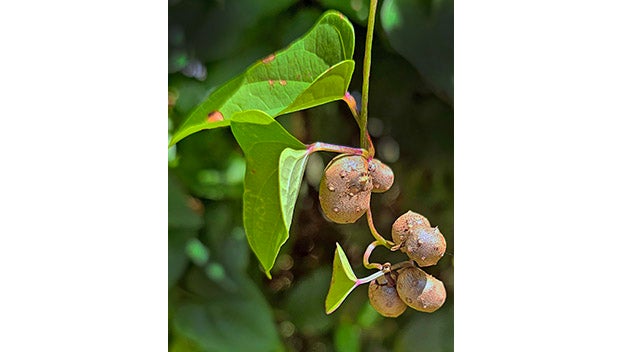Mother Nature’s Garden: The Chinese Yam: Friend or Foe?
Published 1:22 pm Friday, October 6, 2023

- The Chinese yam has attractive bulbils that resemble potatoes.
|
Getting your Trinity Audio player ready...
|
 There are two kinds of alleys in my hometown: The neat, tidy ones with pavement and carefully trimmed edges and then all the others. The ones with potholes, standing water, jungle-like vines, and odd combinations of unknown plants encroaching on the road. Roaming the latter can often lead to some interesting, and at times alarming, discoveries.
There are two kinds of alleys in my hometown: The neat, tidy ones with pavement and carefully trimmed edges and then all the others. The ones with potholes, standing water, jungle-like vines, and odd combinations of unknown plants encroaching on the road. Roaming the latter can often lead to some interesting, and at times alarming, discoveries.
Several weeks ago, I wandered down my alley. It’s well-tended and boring on one side, but the opposite side is overgrown with a mix of plants that includes the good, the bad, and the positively terrible. Within about five minutes, I found sweet peas that had escaped from someone’s garden, Japanese honeysuckle, pokeweed, autumn olive, Chinese privet, greenbriers, common morning glories, sweet autumn clematis, Chinese yam, and climbing milkvine, as well as various brambles and sedges. An untidy jungle that included five plants on the official Virginia state list of invasive species.
Two of the thugs in my alley are vines: Chinese yam and sweet autumn clematis (not on the state list of invasive plants, but still difficult to control). Chinese yam is probably the more interesting of the two. It was introduced to the United States in the late 1800s for use as an ornamental garden plant, but quickly escaped cultivation and is now listed as highly invasive in Virginia.
It’s an attractive, twining vine that covers everything nearby. Without a doubt, my garden is next. Chinese yam twines clockwise and can grow 12 to 16 feet long. It grows from long tubers and has halberd shaped leaves with parallel venation; it’s a monocot. There are occasional flowers that aren’t particularly showy. In late summer, small, warty, potato-like bulbils (aerial tubers) appear in the leaf axils. New plants sprout from the bulbils, and are Chinese yam’s primary means of producing new plants.
Native to Asia, where it’s been used in traditional medicine and as a food source for thousands of years, Chinese yam is an important crop for both domestic consumption and export. The tubers are rich in nutrients and bioactive metabolites, such as resistant starches, that may help prevent cardiovascular disease, diabetes, and problems with the gut biome. Because Chinese yam is so rich in nutrients, can be eaten like potatoes, and grows well in temperate climates, it was sent to Ireland during the potato famine. Agricultural specialists hoped Chinese yam might become an alternative crop, but there was little interest in it.
Since then, scientists have continued to re-examine various uses of Chinese yam. According to research published in 2020, Chinese yam is an underutilized orphan crop that has the potential to help fight global malnutrition and hunger. It grows well in temperate climates, has a long history of cultivation, and produces highly nutritious tubers. There are already at least 14 cultivars currently being grown in China; each cultivar produces a tuber with a distinctive shape that appeals to a specific local market. Unfortunately, Chinese yam is a labor-intensive crop that doesn’t lend itself to mechanical harvesting. In Japan, farmers have partially solved the problem by growing the tubers in long underground tubes, thus facilitating harvesting while also reducing the amount of breakage. Chinese yam is also grown in France and exported to several other European countries.
Chinese yam is definitely an interesting plant with a complicated history. It’s easy to understand why Victorian gardeners were thrilled to grow it on trellises and walls. It had a high value as a novelty and was easy to grow. Unfortunately, one person’s favorite new garden plant is another’s nightmare. Or perhaps with careful cultivation, Chinese yam will eventually become a high value food crop for new areas of the world.
DR. CYNTHIA WOOD is a master gardener who writes two columns for The Herald. Her email address is cynthia.crewe23930@gmail.com.




